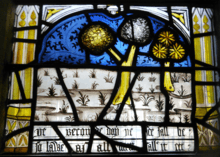Prick of Conscience
The Prick of Conscience is a Middle English poem dating from the first half of the fourteenth century promoting penitential reflection. It is, in terms of the number of surviving manuscripts, the best attested poem in Middle English, with over 130 manuscripts. It was attributed to Richard Rolle in some manuscripts, but contemporary scholars consider the poem anonymous.[1]
%2C_pp_88-89.png)
Appearance in stained glass

Unusually, passages from and illustrations of the account of the Fifteen Signs of Doom in the Prick of Conscience appear in stained glass form in the 'Prick of Conscience Window' in All Saints' Church, North Street, York. The window is thought to have been constructed around 1410–20.[2]
Influence
As the number of surviving manuscripts suggests, the Prick of Conscience was arguably the most popular English poem of the Middle Ages.
Editions
- Ralph Hanna and Sarah Wood, eds. Richard Morris's Prick of Conscience: A Corrected and Amplified Reading Text, Early English Text Society, O.S. 342 (Oxford University Press, 2013)
- James H. Morey, ed. Prik of Conscience, TEAMS Middle English Texts Series (Kalamazoo, MI: Medieval Institute Publications, 2012)
- Richard Morris, ed. The Pricke of Conscience (Stimulus Conscientiae), A Northumbrian Poem by Richard Rolle de Hampole (Berlin: A. Asher & Co., 1863)
References
- James H. Morey (ed.), Prik of Conscience, TEAMS Middle English Texts Series (Kalamazoo, MI: Medieval Institute Publications, 2012)
- Roger Rosewell, 'The Pricke of Conscience or the Fifteen Signs of Doom Window in the Church of All Saints, North Street, York', Vidimus, 45 (n.d.)